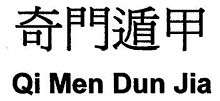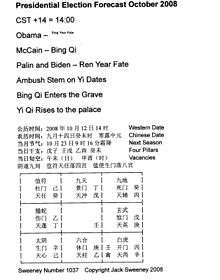Qi Men Dun Jia

Qi Men Dun Jia (simplified Chinese: 奇门遁甲; traditional Chinese: 奇門遁甲; pinyin: Qí Mén Dùn Jiǎ) is an ancient form of divination from China, which is still in use in China, Taiwan, Singapore and the Chinese diaspora in Southeast Asia. Qi Men Dun Jia may be applied to business, crime-solving, marriages and matchmaking, medical divination, Feng Shui, military affairs, finding missing people, travel, personal fortune divination etc.
Along with Da Liu Ren and Tai Yi Shen Shu it is one of the collective Three Arts or Three Styles (三式 sān shì), China's highest metaphysical arts.
History

Originally devised to help form military strategy and tactics, Qi Men Dun Jia was in use as long ago as the period of Chinese history known as the Warring States, and is believed by Chinese scholars to have been used at the Battle of Red Cliffs in the defeat of Cao Cao's ship-borne army.
Liu Bowen is believed to have secured the throne for the Ming dynasty's Hongwu Emperor by applying Qi Men Dun Jia to his strategic planning.
Over the centuries of Chinese history, Qi Men Dun Jia grew in popularity and was expanded to include a number of other types of divination, including medical divination, matchmaking, childbirth, travel, personal fortunes, and today includes contemporary applications, most notably, that of business and finance. Today Qi Men Dun Jia is especially popular in Singapore and other nations of Southeast Asia. Another appropriate translation to it is Mysterious Gates Escaping Technique.
Technique

Qi Men Dun Jia is based on astronomical observations, and consists of various aspects of Chinese metaphysics, including the doctrines of yin and yang, five elements, the eight trigrams, the ten Heavenly Stems and the twelve Earthly Branches, as well as the twenty-four solar terms.
The Qi Men Dun Jia cosmic board consists of a 3 × 3 magic square of nine palaces, which includes a Heaven and Earth pan, a spirit pan, eight gates and a star pan. The various symbols rotate around the palaces with each double hour, making a total of 1,080 different configurations of the Qi Men Dun Jia cosmic board. These "ju" or situations are recycled four times per year, and are divided between the Yin and Yang halves of the year.[1]
Each type of Qi Men Dun Jia divination carries its unique set of Use Spirits (yong shen). For example, medical divination relies mainly upon the Tian Rui Star, the Tian Xin Star, and Yi Qi. The task of the Qi Men Dun Jia analyst is to interpret and analyze the meanings of the symbols in relation to questions asked. Any Qi Men Dun Jia ju may be interpreted or analyzed to respond to a wide variety of questions, or to solve a multitude of problems.
Qi Men Dun Jia is rooted in non-western concepts of time, where time takes on qualities and characteristics, and one segment of time is not necessarily comparable with another. The analyst makes reference to the configuration of the cosmic board at the time when a question is posed, or for birth times of individuals or corporate entities, such as businesses or nations. At times, the same or very similar configurations of the cosmic board will appear in relation to the same series of questions or problems.[2]
See also
- Chinese astrology
- Chinese astronomy
- Chinese Classical Texts
- Da Liu Ren
- Feng Shui
- Flying Star Feng Shui
- Hypernumbers
- I Ching
- Monadology – the metaphysical basis for synchronicity provided in 1714 by Gottfried Wilhelm Leibniz, another student of the I Ching.
- Charles Muses
- Siku Quanshu
- Tai Yi Shen Shu
- Tie Ban Shen Shu
- Yuan Hai Zi Ping
References
- Yang Li (1998) Book of Changes and Traditional Chinese Medicine Paperback, 7.9 × 5.5 inches, 575 pages Beijing: Beijing Science and Technology Press ISBN 7-5304-2025-9; ISBN 978-7-5304-2025-6
Sources
- Du Xin Hui (2003) Xian dai shi lie jing jie qi men dun jia. Yi Li Ren Min Chu Ban She
- Source documents from the Qing Imperial Archive, the Si Ku (四库) or Four Treasures collection.
- Jack Sweeney Introduction to Qi Men Dun Jia.